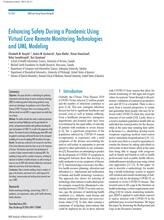
Abstract
Objectives: This paper describes a methodology for gathering requirements and early design of remote monitoring technology (RMT) for enhancing patient safety during pandemics using
virtual care technologies. As pandemics such as COrona VIrus Disease (COVID-19) progress there is an increasing need for effective virtual care and RMT to support patient care while they are at home.
Methods: The authors describe their work in conducting literature reviews by searching PubMed.gov and the grey literature for articles, and government websites with guidelines describing the signs and symptoms of COVID-19, as well as the progression of the disease. The reviews focused on identifying gaps where RMT could be applied in novel ways and formed the basis for the subsequent modelling of use cases for applying RMT described in this paper.
Results: The work was conducted in the context of a new Home of the Future laboratory which has been set up at the University of Victoria. The literature review led to the development of
a number of object-oriented models for deploying RMT. This modeling is being used for a number of purposes, including for education of students in health infomatics as well as testing of new use cases for RMT with industrial collaborators and projects within the smart home of the future laboratory.
Conclusions: Object-oriented modeling, based on analysis of gaps in the literature, was found to be a useful approach for describing, communicating and teaching about potential new
uses of RMT.
Keywords: Remote monitoring technology, assistive living, COVID-19, pandemics, user requirements, safety, public health informatics, health informatics
Yearb Med Inform 2021: http://dx.doi.org/10.1055/s-0041-1726485
